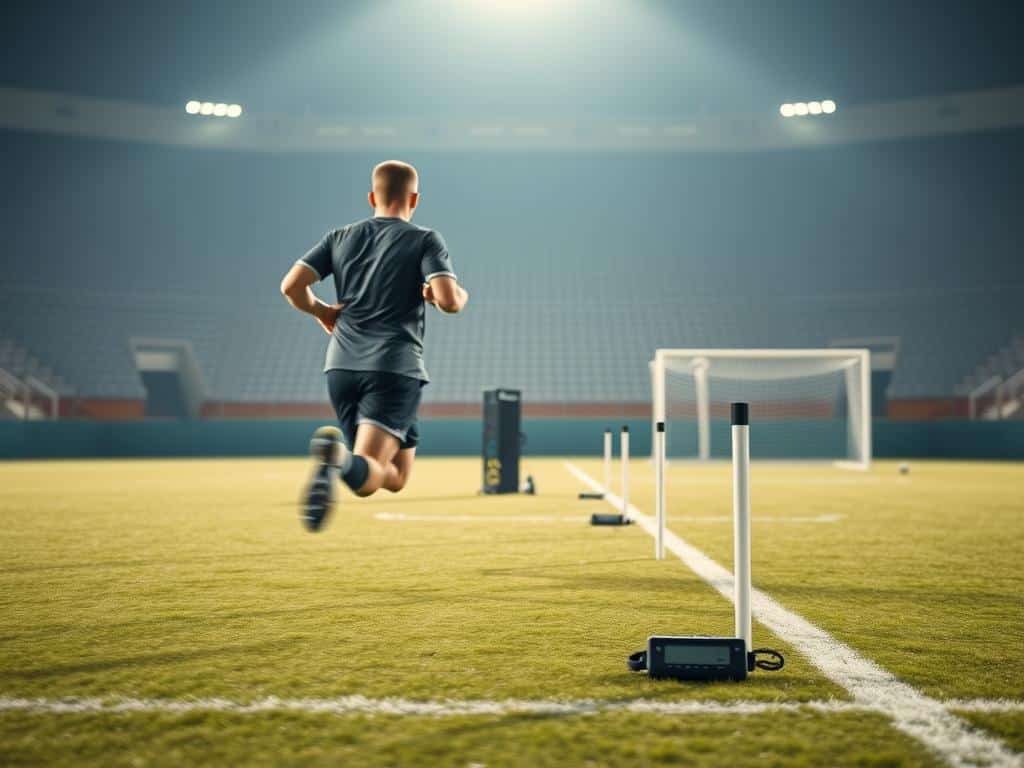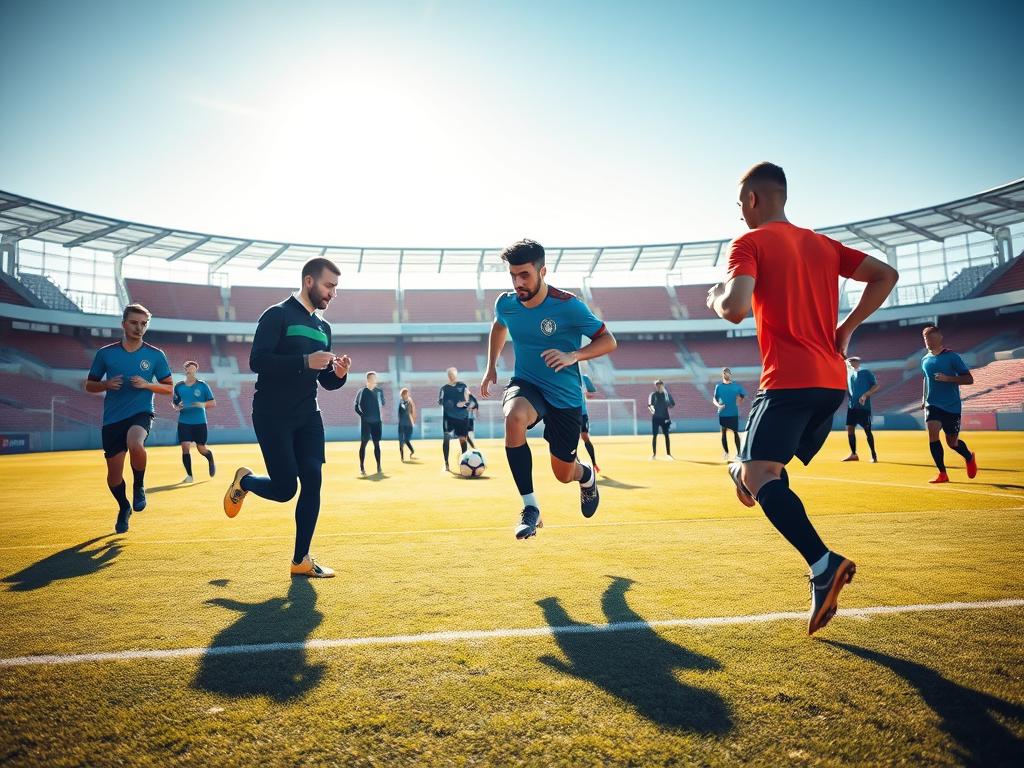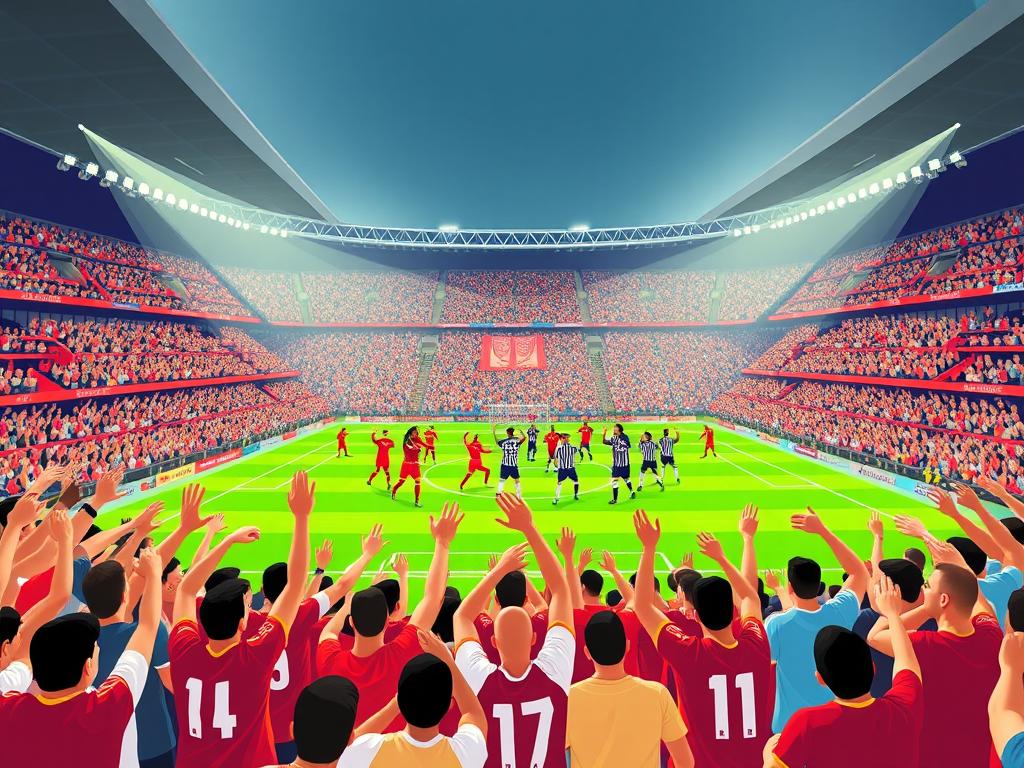Did you know 83% of goals in German pro play are set up by at least one powerful action like a sprint or jump? That fact shows how short bursts decide matches and why measuring those efforts matters.
Field assessments give coaches real, game-like data without heavy lab gear. They capture sprints, changes of direction, and short recoveries—the actions that lead to goals and game-winning plays.
Want tests that actually map to on-field demands? We focus on simple setups you can run on a standard field and use across preseason and the regular season.
Practical, low-cost, and sport-specific—these protocols let teams compare players fairly, shape training blocks, and track true match readiness.
Key Takeaways
- High-intensity bursts, not steady runs, shape match outcomes.
- Field-based assessments reflect real game actions and are easy to run.
- Proper testing links numbers to pressing, sprints, and late-game efforts.
- Use results to individualize training and compare players objectively.
- Simple equipment and clear protocols make repeated testing practical.
Why intermittent, soccer-specific testing beats “The Mile” for players today
Matches are messy: short bursts, pauses, direction changes—and a good test must mirror that chaos. Elite women’s play shows typical work-to-rest patterns of ~4 seconds high intensity, then 44–64 seconds of low effort (Gabbett & Mulvey, 2008). That pattern is what matters on the field.
Top pros do far more high-intensity running. Studies show 28–58% more sprinting than average players and about an 11% edge on Yo-Yo scores (Mohr et al., 2003). Straight sprints lead to goals 45% of the time, and 83% of goals follow a powerful action (Faude et al., 2012).
- Intermittent protocols stress both aerobic and anaerobic energy pathways.
- They reveal how a player manages repeated efforts, quick recoveries, and mechanical changes under fatigue.
- Field tests are cheaper and easier for coaches to run during preseason and the season (Svensson & Drust, 2005).
| Approach | What it shows | When to use | Practical note |
|---|---|---|---|
| The Mile | Continuous endurance | Base conditioning | Misses repeat-sprint ability |
| Yo-Yo style | Intermittent endurance & recovery | Match-readiness checks | High sport specificity |
| Interval sprints | Explosive capacity & repeatability | Acceleration and late-game power | Easy to run on the field |
| Lab VO2 | Metabolic precision | Detailed profiling | Expensive, less game-like |
Soccer fitness test examples for intermittent endurance and recovery performance
Want drills that mirror the stop-start grind of a match and give clean, comparable numbers? Below are field-ready protocols that show how players handle repeated surges and short recovery windows.

Yo-Yo Intermittent Recovery (Level 1 & Level 2)
The yo-yo intermittent setup uses 2×20 m shuttles with a short active break (5 or 10 seconds) between runs. Beeps speed up, and levels rise until exhaustion.
Level 1 starts near 10 km/h and fits broader squads. Level 2 begins around 13 km/h for trained players who need a tougher pace change.
Loughborough Intermittent Shuttle Test (LIST)
LIST mimics match blocks: five 15-minute segments with 3-minute recovery. Each block mixes walks, a 20 m max sprint, ~4 seconds recovery, controlled runs at different intensities, all paced by audio.
FIFA Interval Tests & Futsal shuttle
FIFA Interval 1: 6×40 m sprints with 60 seconds recovery—simple and brutal for repeated high-intensity capacity.
FIFA Interval 2: Alternating 75 m run and 25 m walk for up to 10 laps (4,000 meters) to track intermittent endurance on familiar meters.
Futsal format: progressive 3×15 m shuttles until exhaustion—great for tight turns and repeated accelerations.
- Use these protocols to compare players, set benchmarks, and target recovery-focused training.
| Protocol | Format | What it measures | Best for |
|---|---|---|---|
| Yo-Yo L1/L2 | 2×20 m shuttles, short active break | Intermittent recovery, pacing across levels | Squads & trained players |
| LIST | Match-like blocks, audio paced | Repeated sequences, recovery management | Match-readiness profiling |
| FIFA Interval 1 | 6×40 m, 60 s recovery | Repeated sprint capacity | Speed endurance |
| FIFA Interval 2 / Futsal | 75/25 m cycles or 3×15 m shuttles | Intermittent endurance, turn quality | Endurance and small-sided play |
Agility and change-of-direction tests that mirror football movement
Testing change-of-direction reveals how a player moves under pressure and in tight spaces. These protocols focus on short bursts, quick reads, and clean mechanics.
FIFA CODA Test
The FIFA CODA test mixes forward sprints and lateral shuffles over 8–10 meters to assess how a player changes direction. It highlights quick decision-making in confined zones.
Balsom Agility
Balsom runs a multi-cone pattern with several direction changes and two hard 180° turns. This stresses timing, footwork, hips, and torso control under rapid cuts.
5-10-5 Pro Agility
The 5-10-5 measures lateral speed and direction change performance. It shows who can win duels, stop dribbles, and explode after a turnover.
- Short distances, big insights: split times reveal where a player loses speed in a cut.
- Complements sprints: these tests target braking strength and re-acceleration for game impact.
- Easy set-up: ideal next to technical work for fluid sessions.
| Protocol | Focus | Best use |
|---|---|---|
| FIFA CODA | Forward + lateral, 8–10 meters | Decision-making in tight space |
| Balsom Agility | Multi-cone with 180° turns | Timing and change of direction |
| 5-10-5 | Lateral speed | Duels and recovery bursts |
Speed and sprint tests for acceleration, curves, and repeated efforts
A short sprint can change a game. Measure both first-step punch and the ability to bend a run to see who wins duels.

10-yard dash: measuring first-step acceleration and linear speed off the mark
The 10-yard dash captures the first three steps that decide who reaches the ball first. Use electronic timing for clean splits and repeatability.
Why it matters: it isolates pure acceleration and shows if your work on power is paying off across the season.
Sprint Curve Test (Bangsbo): three-direction change 30 m sprint
The Sprint Curve Test runs roughly 30 meters with three direction changes. Record the fastest sprint, average time, and a fatigue index.
What you learn: how well a player bends runs, brakes, and re-accelerates under pressure. Compare results to elite benchmarks to set targets.
- Pair both tests for a full view: first-step pop plus curved sprint skill.
- Run fresh for best quality; keep setup simple and repeatable.
| Protocol | Focus | Key output |
|---|---|---|
| 10-yard dash | Acceleration | Split times, first-step speed |
| Sprint Curve | Curved sprints | Fastest time, average, fatigue index |
Strength and power testing to support jumps, sprints, and duels
Explosive strength underpins every header, tackle, and explosive run. Coaches need quick, reliable measures to know who is fresh and who needs rest. Two simple approaches give high return on time: the countermovement jump and velocity-based squat profiling.
Countermovement Jump (CMJ): explosive power, jump height, and fatigue insights
The CMJ is fast and telling. It measures jump height and peak power in one jump. If a player’s jump drops over days, that often signals fatigue or reduced energy.
Why use it? CMJ links to winning aerial duels and getting a quick first step off the mark. Track CMJ alongside field work to see translation to ball contests and sprint starts.
Velocity-based squat profiling: estimating 1RM, monitoring readiness, and guiding training loads
Bar-speed tools estimate 1RM without risky max attempts. They show daily readiness by tracking movement velocity at set loads. Drops in bar speed at a usual weight flag fatigue and may prevent injury.
Practical win: brief morning checks let you adjust training loads so players hit the right stimulus on the right day.
- Quick feedback: CMJ gives instant power data so you can decide recovery needs.
- Individualize loads: velocity profiling estimates strength and guides training.
- Durability: regular short tests build players who finish with the same pop they start with.
| Measure | What it shows | When to use | Practical note |
|---|---|---|---|
| CMJ | Jump height, explosive power, fatigue | Daily or pre-session checks | Fast, minimal tech; repeatable |
| Velocity Squat | Estimated 1RM, readiness, load guidance | Weekly or morning screening | Reduces need for max lifts |
| Hip abductor screen | Injury risk, soft-tissue status | Preseason and after heavy blocks | Pre-emptive; simple measures |
Position- and role-specific testing: goalkeepers and referees
Different roles demand different bursts: goalkeepers and referees need tailored checks, not one-size protocols. Here are three role-focused options that map to real match actions and help the team prioritize the right qualities.
Yo-Yo variation for goalkeepers
What it is: A goalkeeper-focused yo-yo intermittent recovery protocol that blends side shuffles, short forward runs, and backpedals over brief meters.
This format mimics stance shifts, quick resets, and box coverage. Work intervals last only a few seconds, with short rest between reps to reflect in-game demands.
Assistant Referee Intermittent Endurance Test (ARIET)
What it is: An intermittent yo-yo-style test with alternating forward and sideways runs timed to match the last defender.
ARIET trains and measures the lateral endurance refs need along the touchline. It helps predict who keeps pace for long halves.
FIT Interval Test
What it is: Circuits over 10- and 25-yard distances with pace shifts, direction changes, and 30-second rest blocks.
This intermittent recovery test layers variable speeds and movement patterns to mimic football rhythm across levels and match seconds.
- One size doesn’t fit all: goalkeepers need short, sharp bouts with lateral shuffles and backpedals.
- Position-specific protocols improve buy-in and yield clearer comparisons across players.
- Keep setups tight and repeatable; fit assessments into technical days to control load and track recovery.
| Protocol | Focus | Best use |
|---|---|---|
| Keeper Yo-Yo | Lateral power, short bursts | Goalkeeper readiness |
| ARIET | Sideways endurance, timing | Assistant referee conditioning |
| FIT Interval | Pace shifts, direction changes | Field players and refs; match rhythm |
Want to reduce injury risk while testing? Pair these role checks with recovery monitoring and simple screens — learn how to prevent and treat match injuries.
How coaches and teams can run tests on the field: timing, setup, and standards
Good testing starts with a plan: clear lanes, reliable timing, and repeatable rest windows. Keep setups simple so data stays clean. Field protocols are lower cost and easier to repeat than lab work (Svensson & Drust, 2005).
When to test in-season and preseason
Plan preseason for baselines and education. Use that time to set standards by position and age (Carling et al., 2009).
In-season, test briefly and often to track recovery and shape weekly training. Schedule sessions after rest or light days. Protect freshness—avoid stacking multiple max efforts back-to-back.
Tracking times, levels, and distances
Use KPIs that matter: Yo-Yo distance/level, sprint splits, and agility times. LIST produces block data (five 15-minute blocks with 3-minute recovery and 20 m max sprints). Yo-Yo reports total meters and level reached. FIFA intervals give defined runs (e.g., 6×40 m with 60 s rest).
- Keep logistics tight: marked meters, consistent surface, and the same timing device.
- Run short circuits: coaches can screen a whole team in 20–30 minutes.
- Standardize rest: within and between drills so results reflect ability, not randomness.
| Action | Why | When |
|---|---|---|
| Baseline battery | Establish norms by position | Preseason |
| Quick screen | Monitor recovery and dips | Weekly/in-season |
| Role check | Position-specific standards | Monthly or after heavy blocks |
From test results to match impact: turning data into smarter soccer training
Turn raw numbers into actions that change match outcomes.
Link KPIs to on-field moments. Yo-Yo outcomes guide conditioning blocks. Sprint and agility splits shape short, sharp micro-sessions that protect rest and build race-winning speed.
Use CMJ and squat velocity as daily readiness reads. If jump height or bar speed drops, tweak the session before problems arise. Track direction and change-of-direction quality across the season to see real transfer to duels and ball wins.
Keep testing tight on time and meters. Communicate results simply with players so they see how a small gain in speed or endurance becomes a game-deciding edge.
Data is a conversation, not a verdict. Use it to adjust, reward progress, and prepare for the next match.







